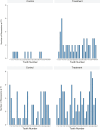Effect of orthodontic treatment with fixed appliances on the development of gingival recession. A prospective controlled study
- PMID: 40432257
- PMCID: PMC12116418
- DOI: 10.1093/ejo/cjaf022
Effect of orthodontic treatment with fixed appliances on the development of gingival recession. A prospective controlled study
Abstract
Objective: To assess in a prospective controlled study whether orthodontic treatment with fixed appliances results in development of gingival recession (GR), compared with an untreated group of participants.
Materials & methods: The sample consisted of 40 consecutive adult orthodontic patients (Intervention group) and 40 untreated adult volunteers, that satisfied the inclusion and exclusion criteria and were selected from the same background population, as the control group. GR was measured as part of a full periodontal assessment: before treatment (T0) and 12 months after removal of the fixed appliances (T1) in the intervention group, i.e. at about 30 months from T0, and at baseline (T0) and 30 months after (T1) in the control group. A count data model was fit using the sum of recessions at T1 and as predictors: treatment, periodontal phenotype (thin/thick), side (buccal/lingual), sex, age, and number of recessions at baseline, with robust standard errors to account for the multiple within patient observations.
Results: Nineteen females and 21 males in each group [mean age in years (range): intervention group 23.1 (16.8 - 43.3); control: 21.85 (18.2 - 43.9)] were analyzed. During the whole study period, the control group exhibited a modest increase in the number of recessions over time. Several patients in the intervention group exhibited a larger increase in the number of recessions than the controls. However, this was partly counteracted by a considerable amount of reduction in the number of recessions in several patients receiving treatment. The adjusted incidence for recession was 67% higher for the intervention group versus the control group (IRR = 1.67, 95% CIs: 1.05, 2.67, P = 0.03). Most recessions, though, were up to 1mm. The most affected teeth were the canines and the first premolars.
Conclusions: Compared to untreated individuals, patients undergoing orthodontic treatment with fixed appliances showed a higher incidence rate of gingival recession at 1-year posttreatment, adjusted for age, periodontal phenotype, side, gender and number of recessions at baseline. However, the severity of gingival recessions was of limited extent.
Keywords: controlled; fixed appliances; gingival recession; orthodontic treatment.
© The Author(s) 2025. Published by Oxford University Press on behalf of the European Orthodontic Society.
Conflict of interest statement
The authors declared no potential conflicts of interest with respect to the research, authorship, and/or publication of this article.
Figures





Similar articles
-
Incidence of Gingival Recessions in Adolescent Orthodontic Patients Treated With Fixed Appliances and Lingual Retainer.J Clin Periodontol. 2025 Apr;52(4):589-598. doi: 10.1111/jcpe.14097. Epub 2025 Jan 8. J Clin Periodontol. 2025. PMID: 39780360 Free PMC article.
-
Effects of fixed retainers on gingival recession - a 10-year retrospective study.Acta Odontol Scand. 2023 Apr;81(3):211-215. doi: 10.1080/00016357.2022.2118164. Epub 2022 Sep 6. Acta Odontol Scand. 2023. PMID: 36067134
-
Does incisor inclination change during orthodontic treatment affect gingival thickness and the width of keratinized gingiva? A prospective controlled study.Eur J Orthod. 2025 Feb 7;47(2):cjaf001. doi: 10.1093/ejo/cjaf001. Eur J Orthod. 2025. PMID: 39917991 Free PMC article.
-
Assessment of the periodontal health status and gingival recession during orthodontic treatment with clear aligners and fixed appliances: A systematic review and meta-analysis.Med Oral Patol Oral Cir Bucal. 2023 Jul 1;28(4):e330-e340. doi: 10.4317/medoral.25760. Med Oral Patol Oral Cir Bucal. 2023. PMID: 36641738 Free PMC article.
-
Post-orthodontic lower incisor inclination and gingival recession-a systematic review.Prog Orthod. 2018 Jun 18;19(1):17. doi: 10.1186/s40510-018-0212-6. Prog Orthod. 2018. PMID: 29911278 Free PMC article.
References
-
- Jepsen S, Caton JG, Albandar JM, et al.Periodontal manifestations of systemic diseases and developmental and acquired conditions: consensus report of workgroup 3 of the 2017 World Workshop on the Classification of Periodontal and Peri-Implant Diseases and Conditions. J Clin Periodontol 2018;45:S219–29. https://doi.org/10.1111/jcpe.12951 - DOI - PubMed
-
- Cortellini P, Bissada NF.. Mucogingival conditions in the natural dentition: narrative review, case definitions, and diagnostic considerations. J Periodontol 2018;89:S204–13. https://doi.org/10.1002/JPER.16-0671 - DOI - PubMed
-
- Agudio G, Cortellini P, Buti J, et al.Periodontal conditions of sites treated with gingival augmentation surgery compared with untreated contralateral homologous sites: an 18- to 35-year long-term study. J Periodontol 2016;87:1371–8. https://doi.org/10.1902/jop.2016.160284 - DOI - PubMed
-
- Chambrone L, Tatakis DN.. Long-term outcomes of untreated buccal gingival recessions: a systematic review and meta-analysis. J Periodontol 2016;87:796–808. https://doi.org/10.1902/jop.2016.150625 - DOI - PubMed
-
- Löe H, Anerud A, Boysen H.. The natural history of periodontal disease in man: prevalence, severity, and extent of gingival recession. J Periodontol 1992;63:489–95. https://doi.org/10.1902/jop.1992.63.6.489 - DOI - PubMed

